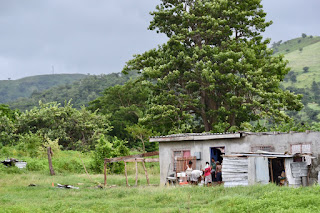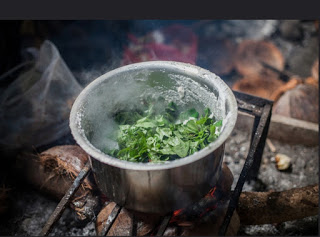The Oldest Person with Hemophilia in Fiji
 |
| Old generation and new: Kunaal and Albert |
 |
| Rural Fiji: en route to town of Ba |
February 14, 2018
A landmark day in Fiji: we met the oldest known person with hemophilia, Albert.
Our day started on this island nation of under a million with a Hemophilia 101 lecture for medical students by Dr. Julia Phillips of New Zealand at Lautoka Hospital, a government medical center. After this, Julia (well versed in driving on the left side of the road) drove on to the small town of Ba, another 40 minutes or so, to meet with
Mr. Albert Perumal, who at age 65, is oldest known person with
hemophilia in Fiji. He has hemophilia A. The drive took us into the rural
areas, where the main roads are well maintained, but the side roads degenerate to
dirt and rocks, as in many if not most developing countries.
Mr. Albert Perumal, who at age 65, is oldest known person with
hemophilia in Fiji. He has hemophilia A. The drive took us into the rural
areas, where the main roads are well maintained, but the side roads degenerate to
dirt and rocks, as in many if not most developing countries.
 |
| Laurie Kelley, Randy Curtis, Albert Perumal, Kunaal Prasad and Dr Julia Phillips |
We passed roadside vendor shops–small, wooden home-made structures selling coconuts, bananas and vegetables. We passed simple homes made of concrete, no windows, edged with tall banana leaves and yards scattered with chickens. Life is simple here, and poor for many.
With me were Randy Curtis of the US, person with hemophilia, long time friend and international advocate; and Kunaal Prasad, a 23-year-old Fijian with hemophilia, who is fast becoming our patient leader in forming a new national hemophilia organization.
We drove up a bumpy dirt road to Albert’s house, a nice concrete structure with even a small
car port, in which everyone sat on couches, next to the car. After polite introductions, we settled down on the chairs and couch, and listened to Albert’s
story.
car port, in which everyone sat on couches, next to the car. After polite introductions, we settled down on the chairs and couch, and listened to Albert’s
story.
 |
| Three men with hemophilia: Randy, Albert, Kunaal |
He started off with the important matters first: his family. He has three daughters, a son, and several grandchildren. He worked
for years as an office clerk, including 15 years as an accountant, back when
there were no computers, he noted. When computers were introduced to do
accounting, he lost his job, as he did not know how to operate them. He then
bought a vehicle, and became a taxi driver. He’s now retired, and has a pension
of $30 a month. $1 US a day… that is
all he has to live on.
for years as an office clerk, including 15 years as an accountant, back when
there were no computers, he noted. When computers were introduced to do
accounting, he lost his job, as he did not know how to operate them. He then
bought a vehicle, and became a taxi driver. He’s now retired, and has a pension
of $30 a month. $1 US a day… that is
all he has to live on.
 |
| Albert’s bedroom |
And he has hemophilia to boot. He had six brothers, four of whom had
hemophilia, three of whom died. One was a twin brother of his. One brother died
at age 40 of kidney failure. Albert’s twin was the first to die, at age 15 from
a simple tooth extraction. The third brother was in a motor vehicle accident at
age 30 when he passed.
hemophilia, three of whom died. One was a twin brother of his. One brother died
at age 40 of kidney failure. Albert’s twin was the first to die, at age 15 from
a simple tooth extraction. The third brother was in a motor vehicle accident at
age 30 when he passed.
In a country that never has had factor, it is remarkable that Albert
has survived so long. He has hemophilia A but doesn’t know the severity. When
he is in severe pain, he goes to Lautoka Hospital, which will offer free care
as a government hospital.
has survived so long. He has hemophilia A but doesn’t know the severity. When
he is in severe pain, he goes to Lautoka Hospital, which will offer free care
as a government hospital.
Albert’s nephew and his sisters live in Australia, and used to send
factor a lot. Now, they cannot, as there has been stricter customs laws. Albert
made us all cringe, but especially Kunaal, our new patient leader, when his
wife offered that when that donated factor expired, he threw it away. We all
politely informed him that it is fine and never, ever to throw away factor. We discussed
ways to share that factor with others, through the newly formed Fiji
Haemophilia Foundation.
factor a lot. Now, they cannot, as there has been stricter customs laws. Albert
made us all cringe, but especially Kunaal, our new patient leader, when his
wife offered that when that donated factor expired, he threw it away. We all
politely informed him that it is fine and never, ever to throw away factor. We discussed
ways to share that factor with others, through the newly formed Fiji
Haemophilia Foundation.
 |
| Albert uses “slippery cabbage” to treat his bleeds |
Albert credits his long life also to local herbs, which the indigenous people, the iTaukei, use for health. They use the mini-heart of the hibiscus, something they call “slippery cabbage.”
He has one grandson, 5 months old, who is not yet diagnosed. Time will
tell, as he may start bruising after toddling about or crawling.
tell, as he may start bruising after toddling about or crawling.
Albert’s wife
brought out tea and biscuits, and we all sipped the red-hot tea and nibbled the
cookies, as a light rain fell. It was a refreshing visit, and an honor to meet
who the oldest known person with hemophilia in Fiji.
brought out tea and biscuits, and we all sipped the red-hot tea and nibbled the
cookies, as a light rain fell. It was a refreshing visit, and an honor to meet
who the oldest known person with hemophilia in Fiji.

